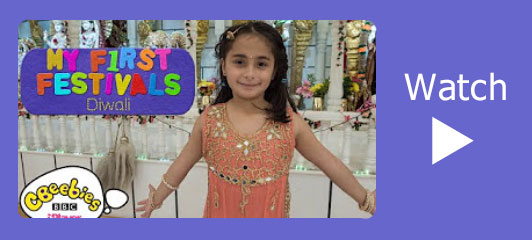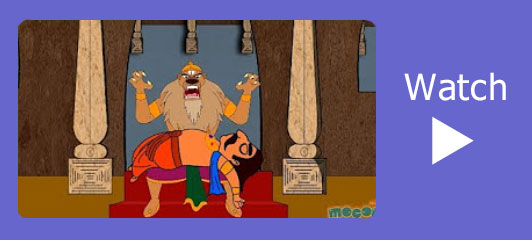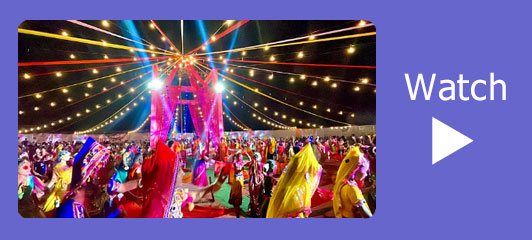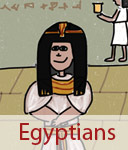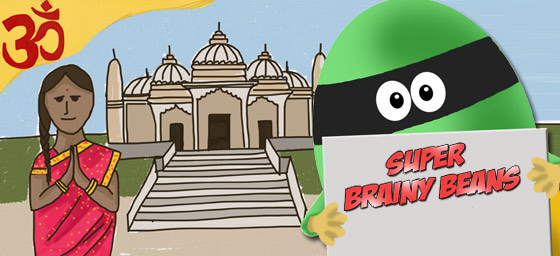
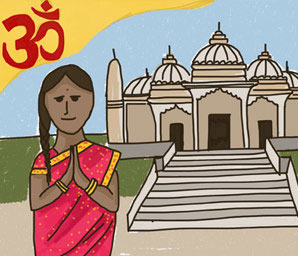
Hinduism for kids
Hinduism for kids in Primary Learning. Homework help with what Hinduism is, how Hindus worship and what their holy festivals are.
What is Hinduism?
Hinduism is one of the oldest religions in the world. It began in India more than 5,000 years ago, and today it is followed by over a billion people, making it the third largest religion in the world after Christianity and Islam.
Unlike some other religions, Hinduism has no single founder. For example, Christians follow the teachings of Jesus, and Muslims follow the Prophet Muhammad, but Hinduism grew slowly over thousands of years. It developed from the traditions, stories, songs, and teachings of the people living in ancient India. These were passed down from generation to generation, often spoken aloud long before they were written down.
Because of this, Hinduism is very rich and diverse. Different groups of Hindus may worship in slightly different ways, celebrate different festivals, or tell different stories, but they are all part of the Hindu faith.
 Bitesize: What is Hinduism
Bitesize: What is HinduismFind out what Hinduism is, worship and holy books.
What is the symbol of Hinduism?
 The most well-known symbol of Hinduism is the Om (or Aum) symbol. It looks a little like the number 3 with a tail and a dot above it. Om is a very special sound in Hinduism – many Hindus chant it when they pray or meditate. It is said to be the first sound of the universe and represents God, creation, and everything that exists.
The most well-known symbol of Hinduism is the Om (or Aum) symbol. It looks a little like the number 3 with a tail and a dot above it. Om is a very special sound in Hinduism – many Hindus chant it when they pray or meditate. It is said to be the first sound of the universe and represents God, creation, and everything that exists.
The sound has three main parts:
- “A” stands for the beginning (like creation and birth).
- “U” stands for the middle (life and living).
- “M” stands for the end (death and rest).
Together, these sounds remind Hindus of the circle of life – birth, life, death, and rebirth.
Hindu beliefs
Hindus believe that every person has a soul, called the atman, which is a part of God and lasts forever. When a person dies, their soul is reborn into a new body. This cycle of birth, death, and rebirth is called reincarnation.
How someone lives their life affects what happens in the next one. This is called karma. If you live kindly, help others, and do good things, your soul will have good karma and be reborn into a happier life. But if someone is unkind or does wrong, they may be reborn into a more difficult life.
The ultimate goal for Hindus is to escape the cycle of rebirth and join with God forever. This is called moksha.
Because Hindus believe the soul is in all living things, they show respect for people, animals, and nature. This is why many Hindus choose to be vegetarian and not eat meat. Cows, in particular, are seen as very special and are often treated with great care.
Many Hindus greet each other by pressing their hands together and saying “Namaste”, which means “I bow to the divine in you.” It’s a reminder that God is inside everyone.
How do Hindu's worship?
Hindus believe that worship, called puja, is a way of showing love and devotion to God. Worship can happen every day at home and also in a temple, called a mandir.
Worship at home
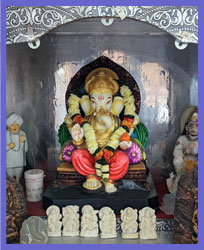 Most Hindu families have a shrine in their house – a special place for prayer. A shrine might be a small shelf, a table, or even a whole room. It usually has pictures or statues of gods and goddesses, along with candles, flowers, and incense sticks.
Most Hindu families have a shrine in their house – a special place for prayer. A shrine might be a small shelf, a table, or even a whole room. It usually has pictures or statues of gods and goddesses, along with candles, flowers, and incense sticks.
Hindus often worship at home in the morning before the day begins. During puja, they use all of the five senses:
- Sight – looking at pictures or statues of the gods.
- Sound – singing hymns or chanting prayers.
- Smell – lighting incense sticks to make the air smell sweet.
- Taste – offering food like fruit, sweets, or rice to the gods.
- Touch – bowing, clapping, or making hand gestures (called mudras) in prayer.
Worship in the Temple (Mandir)
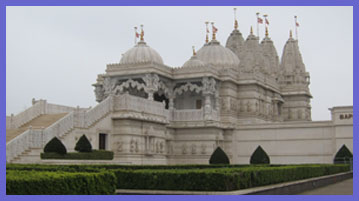 Hindus also worship in a mandir, which is the Hindu temple. Temples are often beautifully decorated and are seen as the home of the gods on earth.
Hindus also worship in a mandir, which is the Hindu temple. Temples are often beautifully decorated and are seen as the home of the gods on earth.
When Hindus arrive at a temple, they usually ring a bell to tell God that they have come. Inside, there are shrines with colourful statues of different gods and goddesses. Worshippers bring offerings such as fruit, flowers, or money.
During temple worship, called arati, a priest waves a lamp with several flames in front of the statue of the god. People place their hands near the flame and then touch their foreheads to show that God’s light and blessing has touched them.
Hindus may also receive a red or orange mark on their forehead called a tilak (or bindi if worn by women). This shows that they have taken part in worship and received God’s blessing.
- After food is offered to the gods, it is shared and eaten by the family. This food is called prasada, which means “blessed food.”
- In some temples, music, singing, and even dancing are part of worship, making it a very joyful celebration.
 United Religions Initiative
United Religions InitiativeHinduism: Sacred spaces and places. Read about temples or mandirs.
Hindu Gods and Goddesses
Hindus believe in one God who can be seen in many different forms. These forms are shown as gods and goddesses, each with their own special qualities and powers. This is why you might hear of so many Hindu gods – they are all different ways of understanding the one divine power.
Most Hindu families have a favourite god or goddess they pray to, and they often keep pictures or statues of them at home or in the temple.
Here are some of the most well-known:
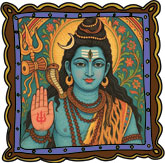
Lord Shiva
Lord Shiva is known as the destroyer of evil. He is not scary, though – Hindus believe he removes pain and suffering from the world so that good can grow. Shiva is often shown with a third eye on his forehead, which represents wisdom, and a snake around his neck. He carries a trident (a three-pointed spear) and is sometimes seen sitting and meditating.
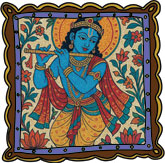
Krishna
Krishna is one of the most loved gods in Hinduism. He is often shown as a young boy playing a flute, which reminds people of joy, music, and love. Krishna is also a great teacher and warrior. In the holy book the Bhagavad Gita, he teaches about living a good life and trusting in God.
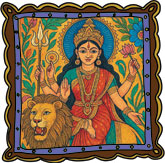
Shakti
Shakti is the goddess of power and energy. She shows that God can be gentle and loving but also strong and fierce when protecting people from harm. Shakti is sometimes worshipped in different forms, such as Durga (the fierce protector) or Parvati (the kind and gentle mother).
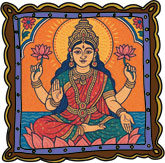
Lakshmi
Lakshmi is the goddess of wealth, good luck, and happiness. People pray to her for success and peace in their homes. She is usually shown wearing red and gold, standing or sitting on a beautiful lotus flower, with coins flowing from her hands to bless her followers.
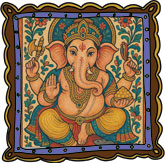
Ganesh (or Ganesha)
Ganesh is the god of wisdom and new beginnings. He is easy to recognise because he has the head of an elephant! Hindus pray to him when starting something new, like a job, a journey, or a school year, to ask for success and the removal of obstacles.
Hindu Festivals
Diwali - The Festival of Lights
Diwali is the most important festival in the Hindu calendar. It is sometimes called the Festival of Lights because people decorate their homes with small oil lamps called diyas.
Diwali celebrates the story of Rama and Sita, who returned home after 14 years in the forest. To guide them back safely, the people of their kingdom lit rows of lamps to light the way. Diwali also welcomes Lakshmi, the goddess of wealth and good luck, into Hindu homes.
At the start of Diwali, many families make beautiful rangoli patterns on their doorsteps using coloured rice, powder, flour, or flowers to invite Lakshmi inside. People clean their homes, exchange gifts of fruit, sweets, and money, and enjoy fireworks to mark the celebration.
 Bitesize: What is Diwali
Bitesize: What is DiwaliFind out what Diwali is and how it's celebrated.
Holi - The Festivals of Colours
Holi is a joyful festival that marks the arrival of spring and the victory of good over evil. It comes from the story of the wicked Holika, who tried to harm her nephew, Prince Prahlad, because he worshipped God. However, Holika was defeated, and Prahlad’s faith was rewarded.
Today, Hindus celebrate Holi by throwing brightly coloured powders and water over each other in the streets, making it one of the most fun and messy festivals in the world! The colours remind Hindus of Krishna, who loved to play tricks by splashing water and colours on his friends in springtime.
 Bitesize: What is Holi
Bitesize: What is HoliFind out what Holi is and how it's celebrated.
Navratri - The Festival of Nine Nights
Navratri means “nine nights” in Sanskrit. This festival lasts for nine days and nights, and it honours Shakti, the goddess of power, in her many forms (such as Durga, Lakshmi, and Saraswati).
Each night, Hindus gather for music, prayers, and traditional dancing, especially a lively circle dance called garba. In some regions of India, colourful sticks called dandiya are used in the dancing, making it very energetic and joyful.
The festival celebrates the triumph of good over evil, especially the story of the goddess Durga defeating a powerful demon.
Famous Hindus
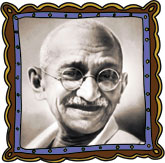
Mahatma Gandhi (1869-1948)
Mahatma Gandhi is one of the most famous Hindus in history. He believed in peace, truth, and non-violence, which he called ahimsa. Gandhi led India’s struggle for independence from Britain without fighting or using weapons. Instead, he encouraged people to protest peacefully, by marching, refusing unfair laws, and speaking out for justice. His Hindu faith inspired him to treat all people with respect, no matter their religion or background.

Kalpana Chawla (1962-2003)
Kalpana Chawla was an Indian-born astronaut and the first woman from India to travel into space. Born in a Hindu family in Haryana, she grew up with values of learning, curiosity, and respect for life — all important in Hinduism.
She studied engineering, moved to the United States, and later joined NASA. Kalpana first flew into space in 1997 and again in 2003 on the Space Shuttle Columbia. Sadly, she and her crew lost their lives when the shuttle broke apart during re-entry.
Kalpana Chawla is remembered as a brave explorer whose achievements continue to inspire millions around the world.
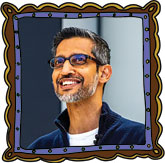
Sundar Pichai (1972– )
Sundar Pichai is a modern Hindu who grew up in India and is now the CEO of Google and Alphabet, one of the biggest companies in the world. He often talks about how his Hindu upbringing taught him to stay calm, work hard, and value education. His success story inspires many children to dream big while staying humble.
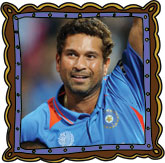
Sachin Tendulkar (1973- )
Sachin Tendulkar, known as the “God of Cricket,” is one of the greatest cricket players in the world and a practising Hindu. He often prays before matches and thanks God for his talents. Millions of people admire him not just for his sporting skills, but also for his humility and kindness.



